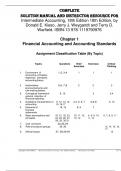Exam (elaborations)
Solution Manual for Intermediate Accounting 18th Edition, by Donald E. Kieso, Jerry J. Weygandt and Terry D. Warfield .Chapter 1- 23 | Complete Guide A+
- Course
- Institution
- Book
Solution Manual for Intermediate Accounting, 18th Edition, by Donald E. Kieso, Jerry J. Weygandt and Terry D. Warfield. Chapter 1-23 A+Solution Manual and Instructor Resource for Intermediate Accounting, 18th Edition, by Donald E. Kieso, Jerry J. Weygandt and Terry D. Warfield. ISBN-13 978-6 Soluti...
[Show more]



